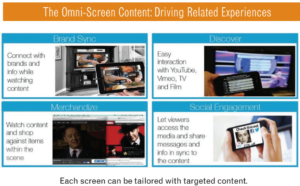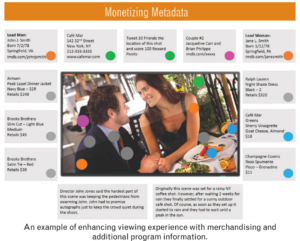Exclusives

M&E Journal: Engagement Across a New Generation of Marketers and Audiences
Story Highlights
By Hank Frecon, CEO, Source Digital –
One of the biggest takeaways from CES 2017 for us was the importance of the “consumer experience.” Attendees and exhibitors alike were in hot pursuit of understanding how to best leverage data in order to improve customer interaction in a wide range of experiences, from pure entertainment to advertising and marketing. Although the attention didn’t start at CES, nor will it end there, many content owners have yet to implement this next wave of marketing technology that improves the search and discovery experience for consumers, ultimately improving customer engagement and loyalty.
There is a breadth of marketing technologies available, but content owners need to understand how they can effectively integrate these technologies into their strategy to further monetize their productions and improve the resulting ROI. At the same time, brands are looking to enhance monetizing content for their products and services.
The multi-screen effect: Adapting to how we advertise in a multi-screen world starts by reaching audiences on every screen with tailored content. Most consumers’ viewing habits include multi-tasking and juggling different activities at the same time, particularly the younger viewing audiences who tend to watch in a more fragmented, on-demand manner. The task of monetizing content in a way that suits this method of viewing pushes monetization strategies to adopt new technologies, so first let’s look at the opportunity.
Viewing habits and data feedback actually provide an opportunity for agility in marketing through a combination of strategies surrounding use of personalization, smart content and omni-screen. The agility lies in the ability to increase consumer engagement and create new revenue opportunities across all media distribution channels.
 Consumers are not just conducting passive or “lean-back” viewing activities across TV screens, tablets and smartphones, they are using these devices to simultaneously research, discover and share–even potentially conducting purchases based on inspirations within the content.
Consumers are not just conducting passive or “lean-back” viewing activities across TV screens, tablets and smartphones, they are using these devices to simultaneously research, discover and share–even potentially conducting purchases based on inspirations within the content.
Recently, Adweek commissioned Survata to survey 1,000 consumers aged 18 to 54 who planned to watch the Super Bowl about their digital consumption around the “big game.” One of the interesting results: 38 percent were likely to search for a brand online after seeing an ad and 29 percent might do so. That “likely” percentage could potentially be much higher if marketing tech strategies for monetizing brands within content were put into place for instant interaction.
Omni-screen content doesn’t live in the same form on every device like multi-screen; it’s about driving related experiences on many screens/devices and each device allowing the viewer to experience the content differently, and even more personally.
Marketing tech is not just about monetization within the screen, it is also about redirecting viewers back to the brand that sponsored the content, and being able to bookmark it for personal use or sharing moments with friends. In addition to the message being there at the convenience of the viewer, the message is personalized using smart content. Omni-screen use increases the potential for consumer engagement and creates a new revenue opportunity.
New opportunities for curation and monetization
Next generation marketers are now realizing the value of underutilized metadata within production to enable them go beyond basic marketing of brands and content. They can now actually monetize moment-based engagements by leveraging the metadata, making the experience more personal.
 Because your content may be viewed anytime, anywhere, your content’s valuable metadata, marketing opportunities, brand extensions, fan-based information, and even in-screen shopping experiences can be conducted across any channel, OTT environment, OVP service or even live programming. This essentially provides opportunities across all media distribution channels—theatrical, TV broadcast, OTT, radio, social media and video streaming.
Because your content may be viewed anytime, anywhere, your content’s valuable metadata, marketing opportunities, brand extensions, fan-based information, and even in-screen shopping experiences can be conducted across any channel, OTT environment, OVP service or even live programming. This essentially provides opportunities across all media distribution channels—theatrical, TV broadcast, OTT, radio, social media and video streaming.
The subsequent analytics that can be derived are extremely valuable in knowing your viewers. By using the valuable data surrounding programming and encouraging viewer interaction, an analytics layer will provide data that surrounds the time and duration, and items of interest tapped into by any viewer watching any content.
Of course, getting this volume of data into place around your content can sometimes be challenging, because not all details or marketing campaigns are ready at the time of staging of your program. Therefore, a properly engineered platform will allow for applying rules to each interaction managing what, who, where, and when.
Through a combination of advanced alignment methods and cognitive tools, the gathered intelligence can be aggregated across categories including scripts, costume design, locations, set design and props, music and editorial metadata, such as an event, scene, span, acts, episode or entire program. This could then be curated against these points of information to properly stage for brand engagement, in-screen merchandising, program discovery, programmatic advertising and fan- based engagement strategies.
Once the data surrounding programming is channeled, it can be offered to partners for B2B examples, such as extending location data to offer a restaurant tour of all restaurants scenes and locations from a popular TV series.
Additionally, there is an opportunity to reach consumers directly in B2C examples, like additional educational information of background material in a documentary. Or, allow the viewer to find out who that actor might be or where they shot that scene. It can even offer up additional e-commerce opportunities for time-based direct to consumer merchandising.
The use of automatic content recognition (ACR) technology, like audio fingerprinting, allows users to engage with audible surroundings for present day and life cycle management around data. Engagement through long-tail programming with contemporary data management will help ensure a library is always dynamic. This addresses the demand for a viewing experience that’s interactive, personalized and social.
 Marketing technology also allows content owners to create some of the most advanced superfan features on the planet, enticing subscription through digital engagement within programming. By taking the content owner’s digital products (behind-the-scenes footage, related VR scenes, character depth, fan theories, production photos and footage, and more), content owners can literally link these digital products directly to any moment against actual footage so fans can go deeper than ever before while watching a program.
Marketing technology also allows content owners to create some of the most advanced superfan features on the planet, enticing subscription through digital engagement within programming. By taking the content owner’s digital products (behind-the-scenes footage, related VR scenes, character depth, fan theories, production photos and footage, and more), content owners can literally link these digital products directly to any moment against actual footage so fans can go deeper than ever before while watching a program.
Source Digital sees smart media creation via metadata and data association as the foundation and force that can bring consumer engagement to new heights with an immediate call-to-action that results in that “impulse purchase.” This is the next wave of marketing tech that enhances the search and discovery experience for consumers, ultimately improving customer engagement and loyalty.
Source Digital’s marketing tech strategies for monetizing brands within content include patented solutions that enable a range of monetization capabilities, such as content as a storefront, brand and product engagement, second level story lines, content discovery and more.
Core IP for managing this type of metadata with these types of goals, allows for rapid identification of an infinite number data attributes across an infinite number of assets at any moment in time.
With a perpetual and custom dataset around evolving content and information, each search will be unique to each viewer and will provide “n” number of personalized experiences. The evolution of targeting will continue with managing metadata to bring consumer engagement to new heights with an immediate call-to-action across the current omni-screen landscape and the eventual day when there will be screenless viewing and engagement.
—
Click here to translate this article
Click here to download the complete .PDF version of this article
Click here to download the entire Spring 2017 M&E Journal









